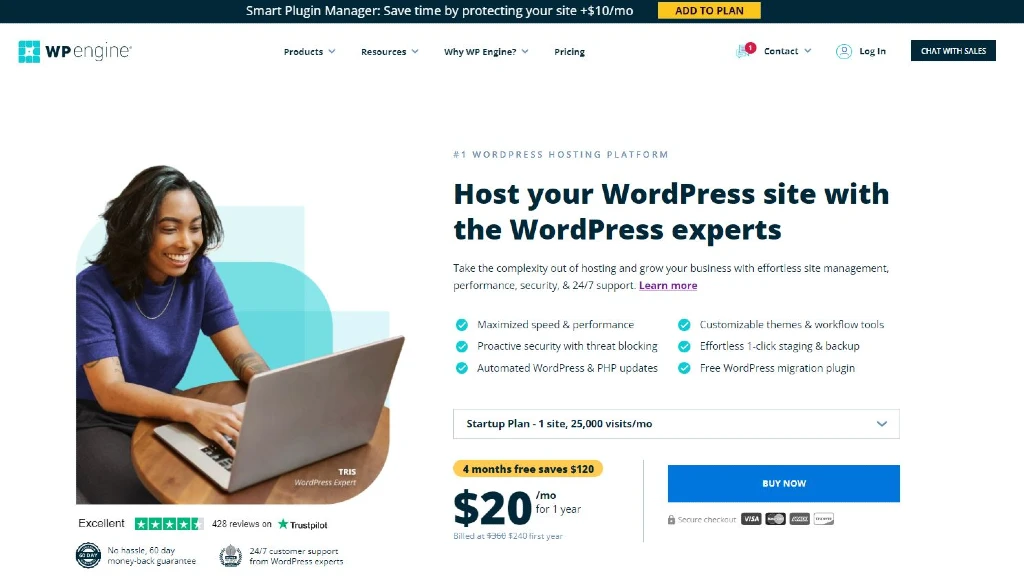
So, you’ve seen the hype about making millions as an affiliate and wondered how to start affiliate marketing and promoting affiliate programs?
Affiliate marketing offers an incredible opportunity for individuals (and businesses) to generate passive income and monetize their online presence.
Statista reports that in the United States, businesses spent $8.2 billion on affiliate marketing in 2022. Furthermore, Influencer Marketing Hub projects that the industry will continue to grow, with estimates reaching $15.7 billion by 2024.
It is a simple, yet effective way to promote products or services offered by other companies and earn a commission or other forms of compensation. One of the key benefits of affiliate marketing is that it requires minimal investment and no inventory or product creation.
All you need is a website or a social media following to start promoting products and earning commissions. Additionally, affiliate marketing allows you to work from anywhere in the world and at your own pace, making it a flexible and convenient way to generate income. Whether you are a blogger, social media influencer, or a business owner, affiliate marketing can help you earn extra income from anywhere.
What is affiliate marketing?
Affiliate marketing is simply marketing in which an individual or business earns a commission for promoting another company’s products or services. The affiliate promotes the products or services through various channels such as a website, blog, social media, or email marketing.
You don’t stock any inventory or worry about any shipping and handling. You’re simply connecting a customer with a company’s product or service – it’s that simple.
How does affiliate marketing work?
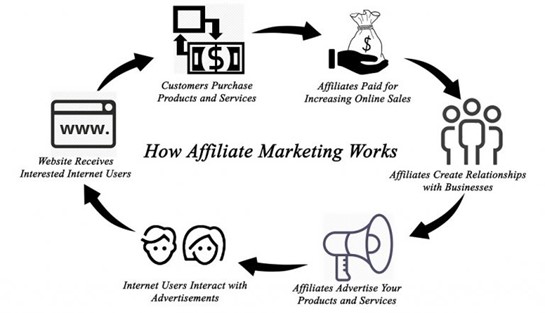
The process of affiliate marketing typically involves the following steps:
- The affiliate promotes the merchant’s products or services through their website or other channels.
- The consumer clicks on the affiliate’s unique referral link, which takes them to the merchant’s website.
- If the consumer makes a purchase or completes a specific action (such as filling out a form), the merchant pays the affiliate a commission or other form of compensation.
The commission can be a percentage of the sale, a flat fee per referral, or other types of compensation such as free products or services.
Be sure to read: Top 10 Affiliate Programs
How to get started: Step-by-Step
Step 1: Choose a Niche
What is a niche?
In affiliate marketing, a niche refers to a specific segment or category of a market that an affiliate targets for promotion. A niche can be defined as a focused area of interest, need, or problem that a group of people share.
Choosing a niche is an essential step in affiliate marketing because it helps the affiliate to focus their efforts and resources on promoting products or services that are relevant to their target audience. By choosing a niche, the affiliate can establish themselves as an expert in that area and build trust with their audience – so be sure to choose an affiliate niche that you’re passionate about. You’ll need to create a lot of content (articles, reviews, how-to guides, etc.) on the topic.
Examples of popular niches in affiliate marketing include health and wellness, beauty and skincare, personal finance, technology, and travel. However, these are too broad and you’ll want to consider micro niches to narrow your focus.
When selecting a niche, it is important to consider factors such as the level of competition, the potential for profitability, and the audience’s level of interest in the topic. By choosing a profitable and relevant niche, affiliates can increase their chances of success and earn significant income from affiliate marketing.
Be sure to review: Top Affiliate Niches and 200 Micro Niches
Step 2: Choose a Domain Name for your Website
What is a domain name?
A domain name is a unique address on the internet that identifies a website. It is a name that people can use to find and access a website on the internet. Think of a domain name as the address of a house, while the website itself is the house.
Be sure to read: How to Choose a Domain Name That Rocks!
For example, if you want to visit a website, you would type its domain name into a web browser (such as Google Chrome or Safari). The domain name will take you to the website’s homepage, where you can view its content and interact with its features.
A domain name consists of two parts: the name itself (such as google or amazon) and the extension (such as .com, .org, or .net). Together, they create a unique identifier for a website. Domain names must be registered and renewed periodically through a domain registrar, and different domain extensions can have different rules and requirements for registration.
What is the difference between a domain name and a URL?
A domain name and a URL (Uniform Resource Locator) are related, but slightly different things.
A URL, on the other hand, is the specific web address of a page or resource on a website. It includes the domain name, as well as additional information that specifies the location of the page or resource on the website. For example, the URL for the homepage of Google is https://www.google.com/, where “https://” is the protocol, “google.com” is the domain name.
In other words, a domain name is a part of a URL, but a URL includes more specific information about the location of a web page or resource within the domain.
How to choose a domain name?
When choosing a domain name, it’s important to consider a name that is both unique and easy to associate with your brand. Don’t get stuck on branding at first, but creating an online presence does involve “branding” yourself or your new company.
No, you don’t have to form an actual company to promote affiliate programs, but in the long run it’s something may eventually do – as many have.
If you have a unique name, you can use your first and last name, for example: SuzanneSmith.com
If someone already has that domain name registered, add your middle initial. Another method is to use your first name along with your niche, for example: FashionsBySuzanne.com
Your domain name does not have to contain any keywords. It can be anything related to your affiliate niche. Simply avoid using hyphens, too many numbers or something difficult to spell. You want your visitors to easily remember your domain name. Also, keep it to no more than three words use the “.com” if you can – it’s simply what most people remember versus the other domain “extensions” like .org or .tv, etc.
Still stuck on trying to figure out a unique domain name? With this free domain name generator, you can effortlessly generate clever and creative domain name ideas that are tailored to your brand or business:
How to register a domain name?
Once you’ve decided on your domain name, you’ll need to see if anyone already has it registered. You can easily do this with Namecheap or GoDaddy – these are the two most common domain registrars.
We recommend Namecheap simply because they have much fewer upsells and less expensive renewal fees. On Namecheap’s home page, simply type in your new domain name and click search to see if it’s available:
Don’t worry if your domain name isn’t available. Simply choose a nuance of your first choice.
Once you’ve nailed down the domain name, it’s on to hosting your website.
Step 3: Setup Website Hosting
Now that you have a domain name (your website’s address), you’ll need to setup website hosting. This is basically the virtual real estate where you’ll build your house – where the files and all the content lives.
Again, because of media hype, GoDaddy is the most well-known. But, we prefer to use a WordPress host such as WPEngine – what this site runs on. WPEngine is optimized for WordPress speed and is easily scalable. Also, WPEngine has free daily backups for your website – this is crucial, believe me.
Get started now by clicking the image and get 4 months free:
Why choose the WordPress platform for an affiliate website?
There are several reasons why WordPress is a popular choice for building affiliate websites. Firstly, WordPress is designed to be user-friendly, making it easy for even those without technical experience to create and manage content. There are tons of free WordPress training tutorials. And, if you’re even a little technical, it’s fairly intuitive and easy to figure out without assistance.
Also, the platform is SEO-friendly, with built-in tools and plugins that can help improve a website’s visibility on search engines. WordPress is also highly flexible and customizable, with thousands of plugins and themes available to extend functionality and customize the website’s appearance.
Over 60% of the top websites are on WordPress!
With a large and active community of developers and users, WordPress offers affordable and cost-effective options for establishing an online presence. Finally, WordPress offers seamless integration with popular e-commerce platforms like WooCommerce, making it an attractive choice for businesses and individuals looking to set up an online store.
There are hundreds if not more website hosting platforms that are cheaper than WPEngine. Trust me, I have tried them. But, you get what you pay for. WPEngine is fast, flexible and their award-winning customer support is amazing.
How to setup your first affiliate website on WPEngine:
1. Login to your new WPEngine portal.
2. Click the Add Site button in the upper right corner:

3. Select how your new website will be used (leave as default):
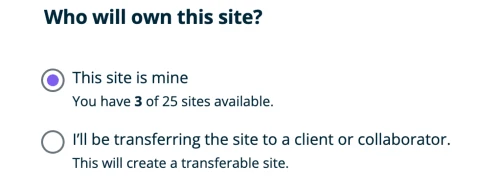
4. Click Start with a blank site and click Next:
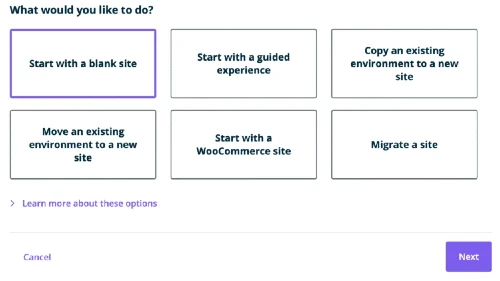
5. Fill in a Site name (usually your domain name or an short form of it) and Environment Name:
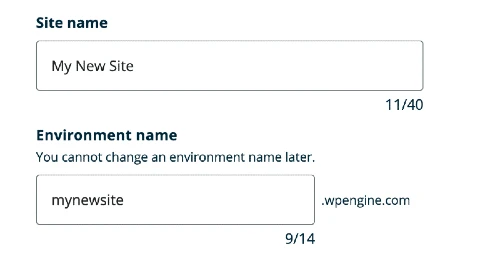
6. Select the Environment type for this new environment.
(Production – you can learn the other environments later)
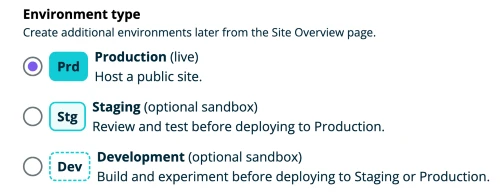
7. Click Add Site to begin the creation process.
That’s it! Your new Site will be created (in less than 10 min) and you will receive an email when the environment has completed it’s setup process.
Step 4: Select a Free WordPress theme and begin building your website.
Login back into your WPEngine portal (or simply refresh after you receive the completion email) and Click the Sites link on the left.
Then, you’ll see your new website. Click the WP Admin button on the right:

The Genesis theme will automatically be setup for you. But, if you’re not happy with it, there are thousands of free themes available. (Appearance > Themes > Add New Theme > Popular)
Don’t get hung up on trying to decide the best one – you can always change themes later – again and again if you wish. One of many reasons WordPress is so popular and incredibly flexible.
Lastly, you’ll begin creating pages and posts. I recommend reserving pages for your primary content. Use blog posts for your shorter – weekly or daily content.
Step 5: Choose your Affiliate Program and the product
How to choose the right affiliate program and product.
Be sure to read: How to Choose the Best Affiliate Program
First, you should understand your audience. What are their issues and pain points and does the product you wish to promote address or resolve these pain points.
Research your niche and ask questions. Also, find out what are the top products out there and if you want to promote one of these. Once you have decided, see if an affiliate program exists.
For example, let’s say you’re into Photography and want to promote photography courses on your website. You can begin searching the affiliate networks (the major affiliate networks are listed in the FAQ below) for a photography course. The major affiliate networks are listed below.
Here’s the dashboard for the Shareasale affiliate network after performing a search on Photography:
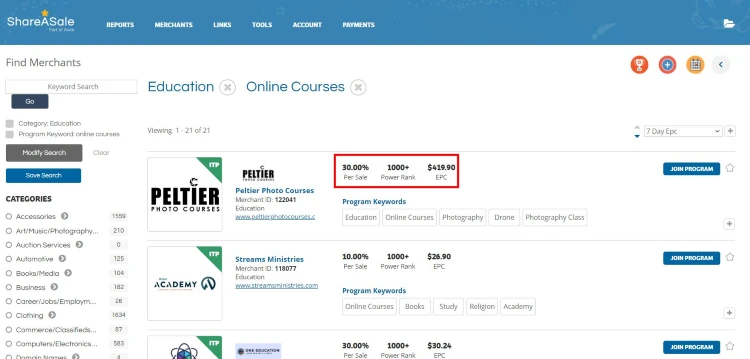
As you can see, the commission rate is 30%. Also, the “Power Rank” is high as well as the “EPC”.
Power Rank is exclusive to Shareasale. It’s simply an indicator of how well this product sells and conversions.
EPC stands for Earnings Per Click, which is a metric used to measure the average earnings generated by each click on an affiliate link. EPC is calculated by dividing the total commissions earned by the number of clicks on the affiliate link.
At this point, you click the Join Program button and apply to be an affiliate. Once approved, they will supply you with your unique affiliate link(s) for this product.
Step 6: Get your affiliate links
Once you have chosen an affiliate program and been approved, getting your links is generally easy. Keeping with the Shareasale affiliate network example – you will receive an email letting you know if you’ve been approved.
Once approved, simply log back into Shareasale and Click the Links menu option at the top.
You will be presented with all the merchants that you have been approved for. Then, you’ll simply click the Get Links button as show below:
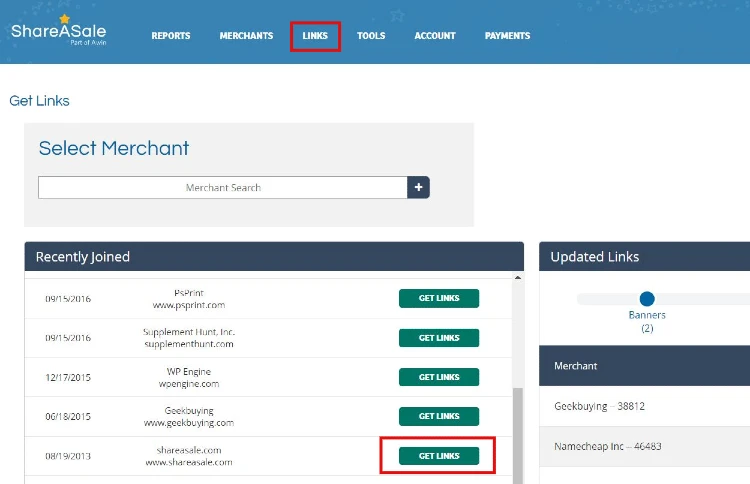
On the next presented screen, you’ll be presented with the main default link (usually to the merchant’s home page) and also have the option of other “text” links or banner links. Banners are simply small graphical advertising pictures with an affiliate link attached.
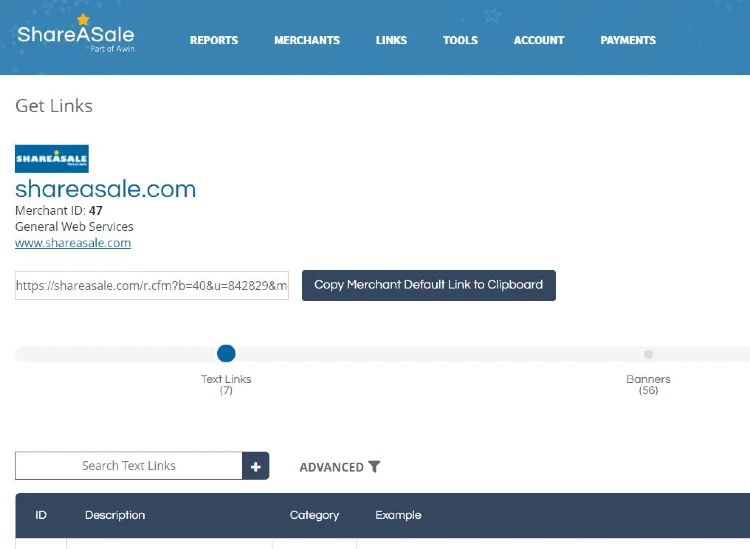
For the text links, simply scroll down a bit and choose a landing page offer or the link to the main site such as this:
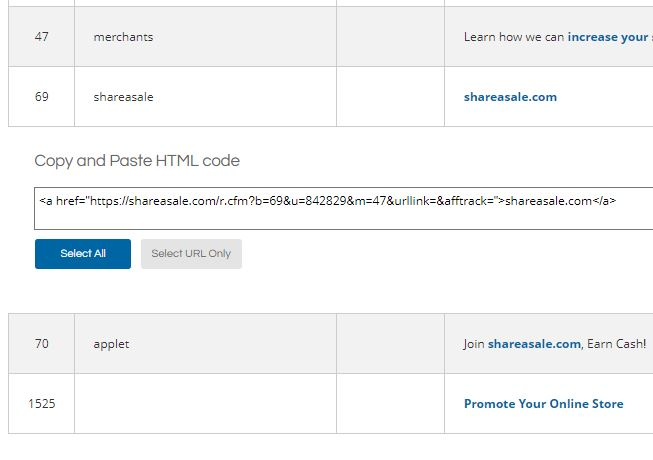
You can copy and paste it as it is into an article on your website. The numbers in the link are your unique affiliate code. What appears at the end, between “>” and “</a>” is the text that will appear. Such as this:
If you hove over the word, you’ll see the hidden affiliate link.
Be sure to visit:
- What is Affiliate Marketing?
- Beginner Affiliate Marketing
- Top Affiliate Niches
- Keyword Research for Beginners
FAQ
What are the key components to affiliate marketing?
Here are some of the key components to affiliate marketing:
- Affiliate: An affiliate is a person or business that promotes the products or services offered by another company.
- Merchant: A merchant is the company that offers the products or services that the affiliate promotes.
- Affiliate Program: An affiliate program is the structure that allows affiliates to promote the merchant’s products or services in exchange for a commission or other form of compensation.
- Commission: A commission is the compensation that the affiliate receives for promoting the merchant’s products or services. This can be a percentage of the sale or a flat fee per referral.
- Tracking: Tracking is the process of monitoring and recording the sales or referrals that are generated by the affiliate’s promotions.
- Creatives: Creatives are the promotional materials provided by the merchant to the affiliate, such as banners, video, text links, and product images.
- Conversions: A conversion is the action that a user takes after clicking on the affiliate’s promotional link, such as making a purchase or signing up for a service.
Successful affiliate marketing requires a strategic approach to promoting products or services to a target audience, building trust and credibility with the audience, and effectively tracking and measuring performance to optimize results.
Affiliate Programs and Affiliate Networks
A company such as Amazon or eBay can have their own (built-in) affiliate program. You sign up and begin promoting their products and service. An affiliate network is something bigger. Think of an affiliate network as a conglomeration of numerous affiliate programs in one place.
An affiliate network is a platform that connects affiliate marketers with businesses or merchants that offer products or services for promotion. The network acts as an intermediary between the affiliate and the merchant, providing a platform for tracking, reporting, and managing the affiliate’s performance and commissions.
Here are five of the top affiliate networks:
- Amazon Associates: Amazon’s affiliate program is one of the largest and most well-known in the industry, offering commissions for promoting Amazon products across a wide range of categories.
- ShareASale: ShareASale is a popular affiliate network that offers a large selection of merchants across various niches, along with a user-friendly interface and advanced tracking and reporting tools.
- CJ Affiliate: Formerly known as Commission Junction, CJ Affiliate is one of the oldest and most established affiliate networks, offering a wide range of merchants and products across multiple industries.
- Awin: Awin is a global affiliate network that offers a large selection of merchants across various niches, along with advanced tracking and reporting tools and a user-friendly interface.
- Rakuten Marketing: Rakuten Marketing is a global affiliate network that offers a large selection of merchants and products, along with innovative tools and resources for optimizing affiliate performance and revenue.
Affiliate networks typically provide a range of tools and resources to help affiliates find and promote products or services that align with their audience and interests. These tools may include product catalogs, promotional materials, tracking and reporting tools, and payment processing.
For merchants, affiliate networks offer a cost-effective way to promote their products or services to a wider audience and increase their sales and revenue. By partnering with an affiliate network, merchants can leverage the marketing expertise and audience reach of affiliates to drive traffic and sales to their website.
How to promote affiliate websites
There are several ways to promote affiliate websites:
- Content Marketing: Create high-quality content that provides value to your target audience, such as blog posts, videos, or social media posts. By offering helpful and informative content, you can build trust and establish yourself as an authority in your niche, which can help drive traffic to your website.
- Social Media Marketing: Utilize social media platforms like Facebook, Instagram, Twitter, and LinkedIn to promote your affiliate website and its content. You can share links to your website, engage with your followers, and use paid social media ads to reach a wider audience.
- Email Marketing: Build an email list of subscribers who are interested in your niche and send them regular newsletters or promotional emails featuring your affiliate products or services.
- Search Engine Optimization (SEO): Optimize your website for search engines by using relevant keywords, optimizing meta descriptions and tags, and building high-quality backlinks to improve your search engine rankings.
- Pay-per-click (PPC) Advertising: Use paid advertising platforms like Google AdWords or Bing Ads to drive targeted traffic to your website by bidding on relevant keywords and phrases.
- Influencer Marketing: Collaborate with influencers in your niche to promote your affiliate products or services to their audience.
By implementing these strategies, you can promote your affiliate website and affiliate links and increase your chances of generating sales and earning commissions. It’s important to experiment with different methods and find the ones that work best for your audience and niche and track what works and what doesn’t.
Initially, you may want to spend money via PPC advertising to get eyeballs on your website. SEO and Content Marketing can be crucial for long term “organic” website traffic.
What’s a good affiliate marketing strategy?
There are many effective and creative affiliate marketing strategies, but here are some key ones that can help you succeed:
- Choose the Right Products: Select products or services that you’re passionate about. You should promote products that you believe in and have used or tested yourself, as this will help you build trust and credibility with your audience.
- Build an Audience: Focus on building a loyal and engaged audience by creating high-quality content that provides value to your target audience. This can include blog posts, videos, social media posts, and email marketing.
- Promote Consistently: Promote your affiliate products consistently through various channels, such as social media, email marketing, content marketing and SEO. Use promotional tools provided by the merchant, such as banners and product images, to promote your products effectively.
- Use Multiple Affiliate Programs: Join multiple affiliate programs related to your chosen niche to diversify your income streams and increase your chances of generating commissions.
- Offer Incentives: Offer incentives, such as bonuses, coupons or exclusive content, to encourage your audience to purchase products through your affiliate link.
- Track Your Results: Use analytics and tracking tools to monitor your affiliate marketing performance and make data-driven decisions to optimize your strategy for maximum results.
- Build Relationships: Develop strong relationships with your audience, other affiliates, social media influencers and the merchants you promote. This can help you gain valuable insights and collaborations that can help your new business explode.
Can I start affiliate marketing for free?
Yes, you can sign up for an affiliate program and get your affiliate links and post on social media or share your links in emails, but this certainly wouldn’t be the way to go. While there are a few initial costs in setting up an affiliate website as described above, this is the model for passive income that keeps earning even when you’re not working on your website – money while you sleep or so the adage goes.
Invest in yourself and your future.
Do I need followers to start affiliate marketing?
Many of us began with zero followers. It’s nice to have a large social media following, but most of us have developed that in time. It’s certainly not required to begin in affiliate marketing. Now, to really add fuel to the fire, beginning a social media presence and building trust and rapport with a growing audience is a great goal to build upon.
Does affiliate marketing really pay?
Yes, affiliate marketing can be a profitable way to make money online. Many affiliates earn a significant income from promoting products and services through affiliate marketing programs. What each earns depends on commission rates.
The amount of money that can be earned through affiliate marketing depends on various factors, such as the niche, audience, affiliate program, commission rates, and marketing strategy. Affiliates who focus on promoting products or services that align with their niche and audience, and who promote them effectively through various channels, can earn a substantial income from affiliate marketing.
However, it’s important to note that affiliate marketing is not a get-rich-quick scheme and requires time, effort, and persistence to build a successful affiliate business. It’s also important to comply with the terms and conditions of the affiliate programs and disclose affiliate links and relationships with merchants to ensure transparency and compliance with regulations
How much can a beginner make in affiliate marketing?
While some beginners may earn less than $5,000 annually, success largely depends on the affiliate’s ability to drive traffic to your affiliate website and how well their audience responds to the affiliate’s promotions. Many veteran affiliate marketers make six figures per year and have moved from a side hustle to full time affiliate marketing.
Keep in mind, Amazon commissions are generally 2-4%. While many other affiliate programs can earn 40-60%. You can do the math here. 10 sales on Amazon may yield $20. While 10 sales on Clickbank could earn $200 – again, depending on the sale price of the product and the commission.
Is affiliate marketing in high demand?
Yes, affiliate marketing is in high demand as it provides a win-win situation for both merchants and affiliates. Merchants can benefit from increased sales and leads without incurring high marketing costs, while affiliates can earn a commission for promoting products or services to their audience.
Affiliate marketing has become increasingly popular in recent years due to the growth of e-commerce and the rise of social media influencers.
According to a report by Statista, spending on affiliate marketing in the United States is projected to reach $8.2 billion in 2022, up from $5.4 billion in 2017.
Additionally, the COVID-19 pandemic has accelerated the growth of e-commerce and online shopping, leading to increased demand for affiliate marketing services. As more people turn to online shopping, merchants are seeking out affiliates to help them reach new audiences and drive sales.
Is it hard to become an Amazon affiliate?
No, it’s not hard at all to become an Amazon affiliate. The process of signing up for the Amazon Associates program is straightforward and can be completed in a few simple steps.
To become an Amazon affiliate, you need to:
- Visit the Amazon Associates website and click on the “Sign Up” button.
- Fill out the application form with your personal and website information, including your website URL, traffic sources, and niche.
- Add Amazon affiliate links to your website or social media channels to start promoting products and earning commissions.
Becoming an Amazon affiliate is a simple process, but it’s important to follow Amazon’s guidelines and best practices to ensure compliance and success in the program.
Also, many affiliate programs want to see an established website getting some traffic. So, it’s recommended you have some content already published on your blog or website in advance.
How do affiliates get paid?
Affiliates get paid through commissions for the sales or leads that they generate for the merchant or advertiser. The commission rate may vary depending on the affiliate program and the specific products or services being promoted.
When an affiliate promotes a product or service and a customer clicks on the affiliate link, a tracking cookie is placed on the customer’s device. If the customer makes a purchase or completes a desired action, such as filling out a form, within the cookie duration, the affiliate will receive a commission for the sale or lead.
Payment methods may vary depending on the affiliate program, but common methods include direct deposit, PayPal, and wire transfer. The payment schedule may also vary, with some programs paying out commissions monthly, bi-weekly, or even weekly.
Do you need a license to do affiliate marketing?
No, not at all. Many affiliate marketers begin as solopreneurs with no official license or company at all. But, once your income begins flowing, you will most likely want to check into an LLC at the very least. This is simply good business practice.
Do you pay taxes on affiliate marketing?
Yes, in the U.S., affiliate program income is still earned income and once you get above $600 in your first year, you are responsible for taxes. I’m no tax expert for sure. Be sure to get in touch with a CPA. And, keep in mind, worrying about paying taxes as an entrepreneur is a good thing. It means you’re making money!


